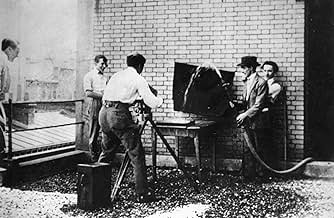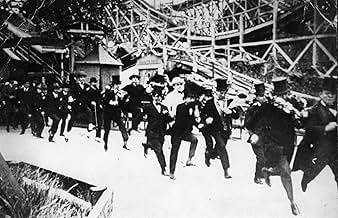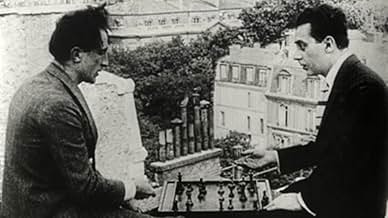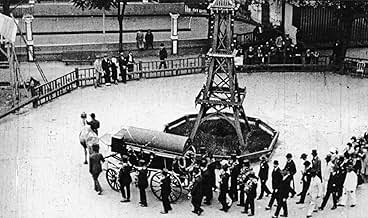Entr'acte
- 1924
- 22min
VALUTAZIONE IMDb
7,3/10
4381
LA TUA VALUTAZIONE
Aggiungi una trama nella tua linguaAn absolute dada movie. Somebody gets killed, his coffin gets out of control and after a chase it stops. The person gets out of it and let everybody who followed the coffin dissapear.An absolute dada movie. Somebody gets killed, his coffin gets out of control and after a chase it stops. The person gets out of it and let everybody who followed the coffin dissapear.An absolute dada movie. Somebody gets killed, his coffin gets out of control and after a chase it stops. The person gets out of it and let everybody who followed the coffin dissapear.
Inge Frïss
- La ballerine
- (as Mlle Frïss)
Man Ray
- Un joueur d'échecs
- (as Man-Ray)
Marcel Achard
- Un homme qui suit le corbillard
- (non citato nei titoli originali)
Georges Auric
- Un homme qui suit le corbillard
- (non citato nei titoli originali)
Georges Charensol
- Un homme qui suit le corbillard
- (non citato nei titoli originali)
Georges Lacombe
- Un homme qui suit le corbillard
- (non citato nei titoli originali)
Roger Le Bon
- Un homme qui suit le corbillard
- (non citato nei titoli originali)
Jean Mamy
- Un homme qui suit le corbillard
- (non citato nei titoli originali)
Rolf de Maré
- Un homme qui suit le corbillard
- (non citato nei titoli originali)
Erik Satie
- Un homme qui charge le canon
- (non citato nei titoli originali)
Pierre Scize
- Un homme qui suit le corbillard
- (non citato nei titoli originali)
Louis Touchages
- Un homme qui suit le corbillard
- (non citato nei titoli originali)
Recensioni in evidenza
Originally played as an intermission with no sound, this film is now a must for any fan/historian of fine art. Featuring cameos by Man Ray, Marcel Duchamp, and other notables, Clair and Picabia's dada collage of different narratives, experimental use of the camera, and surrealist and absurdist images is the best example of experimental or dadaist films from the period. As unusual as it is to watch a film with no sound, the images created by the artists provide an extremely unique experience for the viewer. Fun for anyone, and especially interesting for those acquainted with the artists or the art movements themselves.
I watched Entr'acte (1924) during my first encounter with underground films, specifically in its avant-garde subgenre from the 1920s. This film, along with Buñuel-Dali's Un Chien Andalou (1927), immediately captivated me. Concurrently, I was studying Maya Dere's films, which inspired me to start creating my own underground/amateur/experimental short films between 2012 and 2015.
In Sheldon Renan's book on Underground Film, Entr'acte is considered one of the most impressive avant-garde films ever made. Renan labels it a "predecessor" of the underground film movement, which was then categorized as avant-garde. Entr'acte truly deserves this recognition because, considering the etymology of the term, it was undoubtedly a film ahead of its time. It stood apart from the mainstream Hollywood productions that dominated the era. René Clair, Man Ray, and Marcel Duchamp were acutely aware of the offerings to the strict bourgeois elite in Paris during a ballet concert. In the interlude between acts, they courageously introduced surrealist and dadaist ideas in film, challenging the norms of the time. This act demonstrated that Europe, particularly France, could also pioneer something revolutionary in this art form, breaking away from the conventions of Hollywood and mainstream cinema.
I would like to point out a particular scene in Entr'acte that could be interpreted as a metaphor for this subtle opposition to mainstream Hollywood and commercial films. In this scene, a man in Entr'acte fires a bullet from a shotgun directly at a balloon, which releases a dove. This imagery serves as a metaphor for liberation from the rigidity of standards not only within hegemonic Hollywood but also in cinema at large. It symbolizes the beginning of a new era, marked by the freedom to experiment with various forms and aesthetics. This period reached its peak in the 1960s, embracing a wide range of films that, while diverse in aesthetics, shared the spirit of freedom to explore cinematic possibilities. These filmmakers and artists, along with their successors, played a crucial role in advancing film techniques, many of which were developed specifically for their unconventional creations.
In Sheldon Renan's book on Underground Film, Entr'acte is considered one of the most impressive avant-garde films ever made. Renan labels it a "predecessor" of the underground film movement, which was then categorized as avant-garde. Entr'acte truly deserves this recognition because, considering the etymology of the term, it was undoubtedly a film ahead of its time. It stood apart from the mainstream Hollywood productions that dominated the era. René Clair, Man Ray, and Marcel Duchamp were acutely aware of the offerings to the strict bourgeois elite in Paris during a ballet concert. In the interlude between acts, they courageously introduced surrealist and dadaist ideas in film, challenging the norms of the time. This act demonstrated that Europe, particularly France, could also pioneer something revolutionary in this art form, breaking away from the conventions of Hollywood and mainstream cinema.
I would like to point out a particular scene in Entr'acte that could be interpreted as a metaphor for this subtle opposition to mainstream Hollywood and commercial films. In this scene, a man in Entr'acte fires a bullet from a shotgun directly at a balloon, which releases a dove. This imagery serves as a metaphor for liberation from the rigidity of standards not only within hegemonic Hollywood but also in cinema at large. It symbolizes the beginning of a new era, marked by the freedom to experiment with various forms and aesthetics. This period reached its peak in the 1960s, embracing a wide range of films that, while diverse in aesthetics, shared the spirit of freedom to explore cinematic possibilities. These filmmakers and artists, along with their successors, played a crucial role in advancing film techniques, many of which were developed specifically for their unconventional creations.
René Clair's "Entr'acte" is one of the pioneering films of the surrealist genre in cinema, which, from what I gather, is the attempt at bending reality and twisting all that we've come to know into something deeply strange but entirely mesmerizing. Heavy on its use of perverse or unique imagery and juxtaposition of images and sequences and frequently rejecting the conventions of linear, dramatic filmmaking, such surrealist filmmakers today, such as Quentin Dupieux and Terry Gilliam, focus on a wide-range or visual styles in addition to wacky, out-there humor that is sometimes funny because it doesn't make a bit of sense (otherwise known as "anti-humor").
When it comes to "Entr'acte," however, we have an intriguing piece of film on our hands, one that serves as an early film of the "dadaism" movement in art, where European artists, writers, poets, filmmakers, and theorists began to reject commonly- utilized devices in art of the time in favor of a more radical approach to their mediums. These often included the injection of leftist policies and believes, most specifically anti-war policies that began hitting their stride as World War II neared.
Just by watching the first few minutes of "Entr'acte," one can see that it has no desire at all to try and fit in with conventional artistic standards. It serves as a conglomerate of visuals from the dadaist period, many of which not making very much sense, but each provoking a genre-bending fascination amongst the audience. The opening scene itself is something to marvel at, showing two people firing a cannon from the top of a large building, while strangely-calming and infectious music is played in the background.
The film persists on, with numerous different visuals that were likely never before seen outside of this particular work. What's remarkable is that despite the film's age, scenes involving characters running in slow motion and then being sped up into running in fast-motion after a vehicle still hold a certain kind of power to them. Overall, there's a mesmerizing quality "Entr'acte" bears that is surprising to note seeing as it perfectly defines a film that was "the first of its kind."
Directed by: René Clair.
When it comes to "Entr'acte," however, we have an intriguing piece of film on our hands, one that serves as an early film of the "dadaism" movement in art, where European artists, writers, poets, filmmakers, and theorists began to reject commonly- utilized devices in art of the time in favor of a more radical approach to their mediums. These often included the injection of leftist policies and believes, most specifically anti-war policies that began hitting their stride as World War II neared.
Just by watching the first few minutes of "Entr'acte," one can see that it has no desire at all to try and fit in with conventional artistic standards. It serves as a conglomerate of visuals from the dadaist period, many of which not making very much sense, but each provoking a genre-bending fascination amongst the audience. The opening scene itself is something to marvel at, showing two people firing a cannon from the top of a large building, while strangely-calming and infectious music is played in the background.
The film persists on, with numerous different visuals that were likely never before seen outside of this particular work. What's remarkable is that despite the film's age, scenes involving characters running in slow motion and then being sped up into running in fast-motion after a vehicle still hold a certain kind of power to them. Overall, there's a mesmerizing quality "Entr'acte" bears that is surprising to note seeing as it perfectly defines a film that was "the first of its kind."
Directed by: René Clair.
While not nearly as well-recognized or well-remembered as the Luis Bunuel classic "Un Chien Andalous" (1929), "Entr'acte" is a fairly known work in Dadaism of the 1920's, possibly one of the earliest shorts to focus on the avant-garde rather then attempt a story. Intended as an "entr'acte" (so the title suggests) for the French ballet "Relâche", the film appears to be a mere experimentation with effects while crafting a rather odd plot in the process--and more of a plot than most of the surrealistic works contain. Quite sadly, it was Rene Clair's only attempt at such a form of filmmaking, and had he gone on to lead the movement further he may have come up with even crazier material.
The image most of us remember when we think of this movie (if we do think of this movie, which many may not) is the shot of the bearded ballet dancer, reportedly played by Clair himself. This is a rather odd sight to see in a movie, and one you wouldn't normally see--likewise the rest of the short. Experimenting with slow motion, reverse motion, upside-down and side-to-side camera angles, and a number of dizzying double-exposures, the film's narrative is a rather odd one of a man shooting at a large egg only to be murdered by another man afterwards. This sets up the strange premise and the rest of the film is largely a crazy chase as the mourners of the man pursue his coffin after the hearse gets out of control. The ending, not to be spoiled, (although already spoiled by IMDb's summary) is a weird one to boot.
As others have commented, this short is hardly dark and is more of a comedy to watch than the later surrealist efforts. Plus, the opening sequences (such as the balloon dolls) hardly have anything to do with the rest of the short and the ballet dancer is entirely unconnected to the rest of it. It feels as though they were taking the first few minutes to experiment with other visuals before progressing with the true 'narrative', if one could call it that. Not to be considered a surrealist film, however; the wonderfully dizzying use of exposures is pure Dada all the way. A very creditable early effort in its exceedingly memorable imagery, and every bit as deserving to be a landmark classic as "Un Chien Andalou".
The image most of us remember when we think of this movie (if we do think of this movie, which many may not) is the shot of the bearded ballet dancer, reportedly played by Clair himself. This is a rather odd sight to see in a movie, and one you wouldn't normally see--likewise the rest of the short. Experimenting with slow motion, reverse motion, upside-down and side-to-side camera angles, and a number of dizzying double-exposures, the film's narrative is a rather odd one of a man shooting at a large egg only to be murdered by another man afterwards. This sets up the strange premise and the rest of the film is largely a crazy chase as the mourners of the man pursue his coffin after the hearse gets out of control. The ending, not to be spoiled, (although already spoiled by IMDb's summary) is a weird one to boot.
As others have commented, this short is hardly dark and is more of a comedy to watch than the later surrealist efforts. Plus, the opening sequences (such as the balloon dolls) hardly have anything to do with the rest of the short and the ballet dancer is entirely unconnected to the rest of it. It feels as though they were taking the first few minutes to experiment with other visuals before progressing with the true 'narrative', if one could call it that. Not to be considered a surrealist film, however; the wonderfully dizzying use of exposures is pure Dada all the way. A very creditable early effort in its exceedingly memorable imagery, and every bit as deserving to be a landmark classic as "Un Chien Andalou".
This is an avant-garde movie and as such it's theme and plot are unclear, which is as intended because the movie is ore about special effects than about telling an actual story. This movie directs the audiences' attention to such everyday occurrences as movement, personal interactions, dancing, and running. People are part of some kind of funeral procession, but what catches the attention is the various actions that take place as the procession proceeds. Mourning is replaced by an almost frenetic need to stay active, and the movie shows this through the use of some innovative techniques, including slow-motion, use of montage, and multiple superimposed exposures, all of which convey the sense that something intense is happening. This movie is an excellent example of the French avant-garde genre which had a major influenced on cinematic styles in Europe and the United States.
Lo sapevi?
- QuizThe ballet "Relâche" ("Theatre Closed") premiered at the Théâtre des Champs Elyseés in Paris on December 4, 1924. Based on a book and with settings by Francis Picabia, it was a ballet in two acts commissioned and staged by the Ballets Suédois of Rolf de Maré, with choreography by Jean Börlin. As the title "Entr'acte" implies, this film was shown between the two acts, with music by Erik Satie.
- BlooperObvious stand-in for the close-up of Rolf de Maré getting kicked in head, which sends him (via reverse motion) flying back into the end title. The "kick" itself is clearly achieved through reverse motion.
- Versioni alternativeThere is an Italian edition of this film on DVD, distributed by DNA Srl (2 Films on a single DVD). The film has been re-edited with the contribution of film historian Riccardo Cusin. This version is also available for streaming on some platforms.
- ConnessioniEdited into Avant-garde Cinema (1960)
I più visti
Accedi per valutare e creare un elenco di titoli salvati per ottenere consigli personalizzati
Dettagli
- Tempo di esecuzione
- 22min
- Colore
- Mix di suoni
- Proporzioni
- 1.33 : 1
Contribuisci a questa pagina
Suggerisci una modifica o aggiungi i contenuti mancanti






















